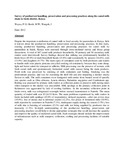| dc.description.abstract | Despite the important contribution of camel milk to food security for pastoralists in
Kenya, little is known about the postharvest handling, preservation and processing
practices. In this study, existing postharvest handling, preservation and processing
practices for camel milk by pastoralists in Isiolo, Kenya were assessed through crosssectional survey and focus group discussions. A total of 167 camel milk producer
households, 50 primary and 50 secondary milk traders were interviewed. Survey
findings showed that milking was predominantly handled by herds-boys (45.0%) or
male household heads (23.8%) and occasionally by spouses (16.6%), sons (13.9%)
and daughters (0.7%). The main types of containers used by both producers and
traders to handle milk were plastic jerricans (recycled cooking oil containers), because
they were cheap, light and better suited for transport in vehicles. Milk processing was
the preserve of women, with fresh camel milk and spontaneously fermented camel
milk (suusa) being the main products. Fresh milk was preserved by smoking of milk
containers and boiling. Smoking was the predominant practice, and was for extending
the shelf life and also imparting a distinct smoky flavour to milk. The milk containers
were fumigated with smoke from burned wood of specific tree species such as Olea
africana, Acacia nilotica, Balanities aegyptica and Combretum spp. Boiling was
practised by primary milk traders at collection points to preserve milk during times
when transport to the market was unavailable. Milk spoilage at the primary collection
point in Kulamawe was aggravated by lack of cooling facilities. At the secondary
collection point in Isiolo town, milk was refrigerated overnight before onward
transmission to Nairobi. The mean quantity of traded milk was 83.2±3.8 litres. The
main problems experienced by milk traders in Isiolo included milk spoilage (43.0% of
respondents), delayed payments—after one or two days (19.9%), loss of money due to
informal courier (12.2%), low prices of fermented milk (10.9%), milk rejection by
customers in Nairobi (7.1%), inadequate supply during dry season (3.5%), loss of
milk due to bursting of containers (2.1%) and milk not being supplied by producers
due to insecurity (1.3%). In-depth understanding of the postharvest handling,
preservation and processing practices would help to devise appropriate strategies that
would increase the quantity and improve the quality of marketed camel milk. Such
strategies should include the improvement of infrastructure such as milk transport,
collection, cooling and processing facilities of suitable capacity. | en |

